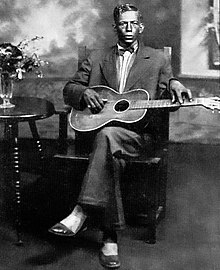
Yes I cried last night and I ain’t gonna cry no more
I cried last night an’ I, I ain’t gonna cry anymore
‘Cause the good book tells us you’ve got to reap just what you sow
Welcome back to another Musical Tree! In this week’s edition I am going to talk about the man many credit with creating Delta Blues – Mr. Charley Patton! I’ll also shed some light on one of the biggest plantations in Mississippi in the early 20th century that today is often referred to as the Birthplace of the Blues.
In researching blues musicians, the name Charley Patton routinely pops up. Perhaps not surprising given that he is often credited with having originated Delta Blues music.
Charley Patton was born sometime between 1885 and 1891 in Hinds County, Mississippi and was of white, black, and Cherokee heritage. Patton’s parents were fairly prosperous and in the early 1900’s they moved to the Dockery Plantation in Dockery, Mississippi. It was here that young Charley decided to pursue a musical career after being inspired by an older guitarist named Henry Sloan. Before I get ahead of myself, I would like to share a brief history of the Dockery Plantation.

The Dockery Plantation was founded in 1895 by William Dockery. After purchasing thousands of acres, it took him years to clear the swampy woodlands in order to get to fertile ground. At its peak Dockery Plantation was its own town, complete with its own elementary school, churches, post office, railroad depot, cotton gin, doctors, and currency! There was a store that sold groceries and furniture. In the early 20th century the Dockery Plantation housed over four hundred tenant families, most of whom were black. Will Dockery had a reputation for treating his workers fairly, and many of them resided there for many years. Charley Patton’s parents would eventually purchase their own land near the plantation where they operated a successful country store.
It was in this environment that young Charley Patton’s guitar playing flourished, and he began singing songs that reflected everyday life in and around the plantation. The type of songs that Charley was playing would define the Delta Blues. By 1910 Charley was teaching and influencing other musicians to play and sing the blues, including Tommy Johnson, Willie Jackson, Howlin’ Wolf, and Roebuck “Pops” Staples, who would go on to form the legendary Staples Singers. Howlin’ Wolf first saw Patton in 1926 after moving to the Dockery Plantation. Patton’s hypnotic three note songs also influenced John Lee Hooker, who recorded his own version of Patton’s ‘Pea Vine Blues’. ‘Pea Vine Blues’ refers to a rail line that ran south from the Dockery Plantation. Railroads would become a staple of blues songs, with hopping on the railroad a symbol of freedom and escape that many blues artist have incorporated ever since. In 1926 Robert Johnson began following Patton to his gigs to learn Patton’s style of guitar playing.
Patton was popular among both whites and blacks. At the Dockery Plantation he often played on the porch of the commissary and at all night parties hosted by Will Dockery. By the late 1920’s Patton was performing throughout the south. He also was performing annually in Chicago. Unlike other blues musicians of that period who often just travelled from place to place, Patton’s gigs were scheduled events, often playing at other plantations and taverns. Patton was only 5 feet 5 inches tall, but it was said that his voice was so powerful that it could be heard 500 yards away!
He was also quite the performer. He would do tricks playing his guitar – playing below his knees, behind his back, or behind his head – tricks that he clearly taught to a young Tommy Johnson that was discussed in a previous Musical Tree. By 1929 Paramount Records decided to bring Charley Patton into the studio to record, and the session resulted in 14 songs, all of which were released as 78’s (That’s a 78 rpm record for those unfamiliar with music in vinyl form). The records sold so well that Paramount invited him back four months later to their brand new, state-of-the-art recording facility located in Grafton, Wisconsin. There Patton would record another 28 songs. Patton’s final recording session was in 1934 for Vocalion Records in New York City, where he recorded another dozen songs.
One of Patton’s songs was called ’34 Blues’. In this song Patton sings of being banished from Dockery Plantation by the plantation manager, Herman Jett, apparently because Patton was running off with various plantation workers women.
By 1933 Patton had settled in Holly Ridge, Mississippi with his common law wife and recording partner, Bertha Lee. Their relationship was very turbulent. Early in 1934 they were both incarcerated in the Belzoni, Mississippi jail after a nasty fight. Shortly after making his final recordings in New York City Patton returned to Holly Ridge where he died suddenly on April 28, 1934. The official cause of death was a mitral valve disorder. His death was not reported in the local newspapers, and he was buried in a cemetery in Holly Ridge. In 1990 a headstone was finally erected on his gravesite. The location of his grave was identified by the cemetery caretaker, who claimed to have been present at the burial 56 years earlier. The headstone was paid for by John Fogerty, lead singer and guitarist for the band Creedence Clearwater Revival.
Charley Patton’s influence among musicians did not end in the Delta. The rock band Canned Heat covered a number of his songs. Bob Dylan dedicated the song ‘High Water (for Charley Patton)’ on his 2001 album titled ‘Love and Theft’ to Patton. In 2017 Taj Mahal covered Patton’s song ’High Water Everywhere’ for the award-winning documentary ‘The American Epic Sessions’. Finally, just a few weeks ago, the Rock and Roll Hall of Fame elected Charley Patton into the hall as an Early Influence. I find this rather ironic, given that if you trace the musical influences of the vast majority of artists that are already in the hall, that trail would (and indeed, does!) lead back to one Mr. Charley Patton. It appears that finally he has reaped what he has sowed!
I hope you enjoyed this week’s Musical Tree! Feel free to leave suggestions for future articles in the comments. Don’t forget to subscribe to be notified via email when there is a new post.
And you can now follow Tekesmusings.com on your social media of choice by clicking on the links at the bottom of the page! Until then, follow your passion, stay happy, and be thankful for whatever inspires you.


Thanks for digging deep into the blues and highlighting the root of the Delta Blues. Another great edition of The Musical Tree. Thanks.
Thank you!